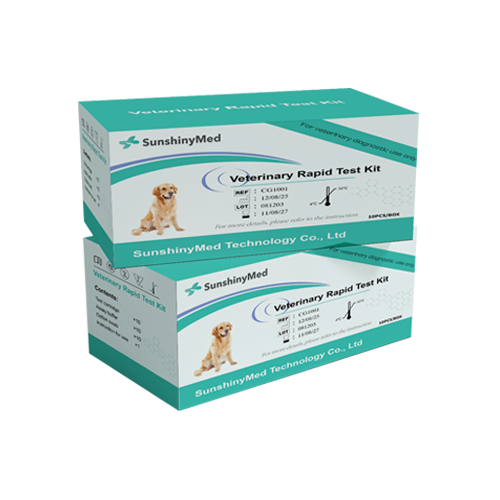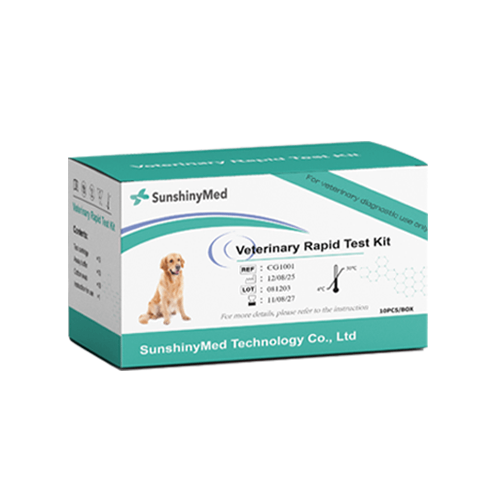


Canine Coronavirus Antigen Rapid Test
Canine Coronavirus (CCV) is a virus that affects the intestinal tract of dogs. It causes a gastroenteritis similar to parvo. CCV is the second leading viral cause of diarrhea in puppies with canine Parvovirus (CPV) being the leader. Unlike CPV, CCV infections are not generally associated with high death rates. CCV is a highly contagious virus affecting not only puppies, but older dogs as well. CCV is not new to the canine population; it has been known to exist for decades. Most domestic dogs, especially adults, have measurable CCV antibody titers indicating that they were exposed to CCV at some time in their life. It is estimated that at least 50% of all virus-type diarrhea is infected with both CPV and CCV. It is estimated that over 90% of all dogs have had exposure to CCV at one time or another. Dogs that have recovered from CCV develop some immunity, but the duration of immunity is unknown.
CCV is a single stranded RNA type of virus with a fatty protective coating. Because the virus is covered in a fatty membrane, it is relatively easily inactivated with detergent and solvent-type disinfectants. It is spread by virus shedding in the feces of infected dogs. The most common route of infection is contact with fecal material containing the virus. Signs begin to show 1-5 days after exposure. The dog becomes a “carrier” for several weeks after recovery. The virus can live in the environment for several months. Clorox mixed at a rate of 4 ounces in a gallon of water will destroy the virus.
The SunGold™ Canine Coronavirus Antigen Rapid Test is a rapid diagnostic tool based on colloidal gold immunochromatography technology. Its principle is to use specific antibodies to bind to canine coronavirus antigens to form a visual detection line on the test strip, thereby realizing the rapid identification of canine coronavirus infection.
Production Features
Simple sampling
Easy to operate
Results in 10 minutes
Reduce testing costs
Product Parameters
| Production Name | SunGold™ Canine Coronavirus Antigen Rapid Test |
| Usage | Veterinary Diagnostics |
| Detection Method | Chromatographic Immunoassay/Lateral Flow Immunoassay |
| Target Analyte | Canine Coronavirus Antigen |
| Specimen Type | whole blood, serum or plasma sample |
| Storage Temperature | 4-30°C |
| Result Time | 5-10 Minutes |
| Packaging Specification | Individually sealed, 10 tests in total. |
| Format | Cassette |
| Shelf Life | Up to Expiration Date Indicated on Package |
Product Performance
| Sensitivity | 97.58% |
| Specificity | 97.96% |
| Accuracy | 97.70% |
Description
This kit is suitable for on-site initial screening and diagnosis of dogs in animal hospitals, pet clinics, kennels and other scenarios, especially when dogs have gastrointestinal symptoms such as vomiting and diarrhea, to provide timely diagnostic basis for clinicians. The background of the project development is based on the fact that canine coronavirus is highly prevalent and spreads rapidly in puppies. Although traditional detection methods such as PCR have high sensitivity, they require professional equipment and a long detection cycle. Therefore, this kit came into being. It is suitable for front-line veterinarians to make quick decisions, which will help to control the epidemic early and improve the efficiency of prevention and control.
How to use?
Check the product contents and make sure the test operation is under the room temperature (15–30℃) before testing.
Unseal the extraction tube containing the buffer.Place the extraction tube in the workstation.
Use the swab to collect some fresh canine feces or fecal sample from its rectum. And then put the swab into the buffer.
Rotate the swab more than 10 times.Close the cap of the buffer tube.
Take the test device out of the aluminum foil bag and place it on a clean and flat table. Add three drops (about 90 μL) of specimen (mixed sample) vertically into the specimen well(S) of the test device.
Interpretation of Results
Positive (+): The presence of both C line and T line, regardless of T line being strong or faint.
Negative (-): Only clear C line appears.
Invalid: No colored line appears in C region, regardless of T line's appearance.
Materials provided:
10 test cards
10 vials of assay buffer
10 bags of swab stick
1 package insert


